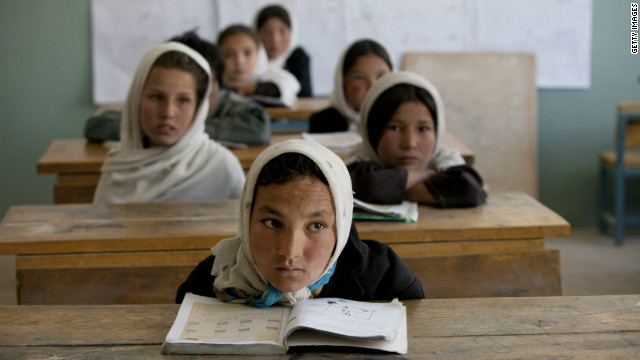Make schools safe for girls everywhere
updated 9:57 AM EDT, Thu October 11, 2012

In the peaceful province of Bamiyan, Afghanistan, girls attend school without fear, unlike in Taliban-heavy areas.
STORY HIGHLIGHTS
- Jennifer Buffett: Girls everywhere want to go to school to get a better future
- Buffett: Sadly, pursuing an education can be dangerous as girls encounter violence
- She says on the first United Nations International Day, make girls' safety a priority
- Buffett: We can do our part to help girls by making sure schools are harmless places
Editor's note: Jennifer Buffett is the president of NoVo Foundation, an organization that seeks to empower girls and women worldwide and to end the violence and exploitation against them.
(CNN) -- Tuesday was a tragic day for girls everywhere. In Pakistan, 14-year-old Malala Yousufzai was shot by the Taliban on her way home from school on a bus. Although she was targeted specifically because she spoke out against the Taliban's suppression of women's education rights, her story serves as a reminder of the obstacles that girls face in trying to obtain schooling.
In all my travels, from
Liberia and the Democratic Republic of Congo to villages and towns
across rural India, I have been struck by the unwavering commitment of
every girl to do one simple thing: Go to school.
Just like Malala, the
girls I met know that education is their ticket to a better future: for
themselves, their families and their entire communities.

Jennifer Buffett
Girls would beg their
parents to let them stay one more year in school, struggling to juggle
their household chores with caring for their younger siblings, all so
they can squeeze in one more day in the classroom.
Unfortunately, girls
around the world have also shared with me how pursuing an education can
be dangerous, whether it's because of harassment and violence from
teachers or the dangers they encounter as they walk to school.
Today, as we celebrate
the first United Nations International Day of the Girl by marking the
progress that has been made for girls, we should keep in mind that we
need to redouble our effort to create a future in which all girls can
safely receive an education and reach their full potential.
 Malala in 2011: My people need me
Malala in 2011: My people need me
 Taliban gunmen shot teen activist
Taliban gunmen shot teen activist
Violence keeps girls out
of school. Globally, nearly half of all sexual assaults are committed
against girls who are 15 and younger. Fear of this type of violence
restricts where girls are allowed to go and when they are allowed to be
out of the home. Often, parents do not send their daughters to school
for this reason.
Violence in the home can
also hold girls captive and out of school. For instance, nearly half the
girls in developing countries are married during their teenage years,
with many before age 15. They may experience profound violence at the
hands of their often much older husbands.
But sadly, school does
not equal safety. Even girls who are able to go to school still face
violence -- in the classroom, of all places. A girl may walk up to five
kilometers between home and school in the company of friends or an older
brother to avoid the inevitable harassment by groups of men or boys she
passes, only to receive more harassment from a teacher once she finally
reaches school.
In schools around the
world, teachers pressure girls for sex in exchange for grades. In
Zambia, for example, more than 2,000 cases of teacher rapes were
reported in 2010 alone. Of these cases, only 240 teachers were
convicted. While these numbers may be shocking, Zambia is not the only
country with this problem. Schools should be a safe haven for girls, but
instead, they are too often a place of fear and danger.
However, despite the
violence that can happen in schools, going to school tends to increase
girls' safety outside school. A recent study in Swaziland found that the
risk of childhood sexual violence was greatest among those who were not
attending school, suggesting that greater educational opportunities
decrease vulnerability to violence. Girls in school have an opportunity
to escape early marriage and early motherhood, and to gain skills that
give them enhanced economic and social opportunities.
As part of the global
community, we can all do our part to help girls by making school safe
and making sure they can get to school. Here are a few ways:
-- Invest directly in
girls. Less than 2% of every international development dollar goes
directly to adolescent girls, let alone toward protecting them from
violence. We have made great strides globally in increasing the numbers
of girls in primary school, but until we make girls' safety a priority
we will not advance our educational goals.
-- Ensure schools are
accountable to girls by enacting and enforcing policies that prevent
sexual abuse and exploitation by teachers. When a 13-year-old girl in
Zambia was repeatedly raped by her teacher, the Adolescent Girls Legal Defense Fund
supported the girl's court case against the teacher who raped her and
the headmaster who knowingly allowed the assaults to occur. In 2008, the
High Court of Zambia ruled that the Zambian government is responsible
for protecting girls from sexual assault and providing recourse to
victims. Schools everywhere must enact systems that protect girls and
hold teachers accountable.
-- Empower schools and
girls through provision of safe spaces. One important outcome of the
Zambian teacher rape case has been the wide scale adoption of safe
spaces for girls in Zambian schools.
-- Recruit, train and
retain female teachers. Female teachers can reduce some of the major
risks adolescent girls face in school. They can also serve as strong
role models and help girls imagine different futures for themselves.
The 10x10 Campaign is uniting people and organizations around the critical goal of removing barriers to girls' education. Likewise, so is the Adolescent Girls Legal Defense Fund. You can join them.
The benefits of
education for girls are undeniable. But until we can ensure that schools
are places of learning, rather than places of danger, girls will be
held back. When girls are educated—and safe—they, along with our entire
societies, will flourish.While the story is done, here's a parting shot. Cowards on a bus picking on girls. That is a man for you in that circle of the world that thinks that way. Shame on you!

No comments:
Post a Comment